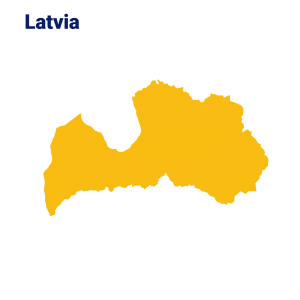In many regions the coherence of local data is limited, experience with generic data is low, and the capacity to synthesise this information into a comprehensive risk analysis with well-defined and ranked risk indicators is sparse.
In order to tailor the framework and tools to the needs in this local context, CLIMAAX partners exploited dedicated use cases, and sampled the experience with regional risk assessment projects existing in the consortium.
A total of 5 regional Climate Risk Assessment (CRA) pilots have been executed to co-design the CLIMAAX Framework and Toolbox. For a variety of European regions, the consortium selected two city regions and several sectors and communities with different environmental and societal risk profiles. Find out CLIMAAX pilots!

LATVIA
Latvia is a country in Northern Europe that lies on the eastern shores of the Baltic Sea, with a land size of about 65K km2 and a population of 1.9M.
Most of the territory is less than 100 m above sea level: undulating plains cover 75% of Latvia and provide the main areas for farming while 25% of the territory lies in uplands of moderate-sized hills. Latvia has an abundant network of rivers, contributing to the visual beauty and the economy of the country.
The greatest risks associated with the climate in Latvia are sea-level rise and storm surges, storms and the resulting damage to infrastructure and forests, river flooding, droughts, and the resulting wildfire risks and effects on crop yields, as well as extreme precipitation and fluvial floods.


SETÚBAL
Setúbal is the fifth largest Portuguese city, and capital of a District with over 800K inhabitants. It is located in the estuary of the river Sado, on the Atlantic Coast, and is part of the Lisbon Metropolitan Area.
The territory is characterized by a large urban area (City of Setúbal) and a more dispersed occupation to the east and west. About 50% of the Municipality’s territory is classified as a protected natural area.
Regarding climate change, rural and forest fires are the greatest risk to the territory. The low water retention capacity of soils contributes to flash floods triggered by intense rainfall concentrated in a few hours, generating high risk to people and economic, environmental, and property damages.
CATALONIA
Catalonia is a region in the northeast of Spain with a marked geographical diversity, conditioned by the Mediterranean coast, with 580 kilometers of coastline, and the towering Pyrenees along the long northern border.
The capital and largest city, Barcelona, is the second-most populous municipality in Spain and the fifth-most populous urban area in the European Union.
With a population of over 7.5M inhabitants and an economy with a big component based on tourism and agriculture/food, Catalonia is a region with a huge exposure to climate-related hazards; flash floods and forest fires are the main hazards.


ŽILINA
Žilina is the fourth largest city of Slovakia, home to 80K inhabitants, and the capital town of a Region and a District of the same name. Žilina is located in the north-central part of the country, at the confluence of Váh, Kysuca, and Rajčianka rivers.
The Žilina valley is characterised by continental climate and is exposed to a host of climate-related risks, including pluvial and fluvial floodings (and natural hazard-induced technological risks), protracted droughts (and subsequent forest dieback), forest fire, landslides, and extreme heat.
FINLAND
Finland is characterized by its northern position, its ubiquitous landscapes of intermingled boreal forests and lakes, and its low population density. The territory can be divided into three areas: archipelagoes and coastal lowlands, a slightly higher central lake plateau and uplands to north and northeast.
Even though the Climate Risk Assessment in Finland is generally of good standard, further development is needed, especially considering the climate change induced changes to extreme weather events, like windstorms, snow conditions, heat waves, and forest fires.


This project has received funding from the European Union’s Horizon Europe – the Framework Programme for Research and Innovation (2021-2027) under grant agreement No. 101093864.

This project has received funding from the European Union’s Horizon Europe – the Framework Programme for Research and Innovation (2021-2027) under grant agreement No. 101093864.